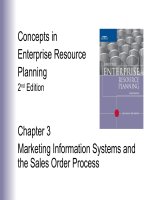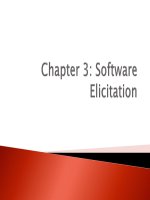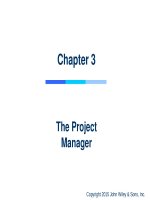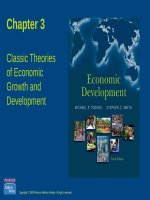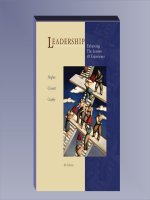Lecture Communication skill: Chapter 3 - Tracey Bretag, Joanna Crossman, Sarbari Bordia
Bạn đang xem bản rút gọn của tài liệu. Xem và tải ngay bản đầy đủ của tài liệu tại đây (245.99 KB, 31 trang )
Chapter 3
Essay writing
Copyright 2009 McGraw-Hill Australia Pty Ltd
PPTs t/a Communication Skills, by Bretag, Crossman and Bordia
1
3-1
Learning objectives
On completion of this chapter students will
know how to:
• prepare a research plan for an essay
• prepare a writing plan for an essay
• present persuasive arguments
supplemented with references
• write a well-presented academic essay.
Copyright 2009 McGraw-Hill Australia Pty Ltd
PPTs t/a Communication Skills, by Bretag, Crossman and Bordia
2
3-2
Why write essays?
• To analyse a topic closely
• To develop a point of view in relation to a
topic
• To persuade the reader that your position is
well supported by the ideas and information
you present.
Copyright 2009 McGraw-Hill Australia Pty Ltd
PPTs t/a Communication Skills, by Bretag, Crossman and Bordia
3
3-3
Steps in writing an essay
•
•
•
•
•
•
•
•
•
Choose the question
Analyse the question
Make an initial plan
Locate the resources
Read and make notes
Write the first draft
Revise and redraft
Organise the reference list
Proofread
Copyright 2009 McGraw-Hill Australia Pty Ltd
PPTs t/a Communication Skills, by Bretag, Crossman and Bordia
4
3-4
Choose the question
• Which topic interests you the most?
• Which has good resource material
available?
• Which is relevant to you personally or
professionally?
• Which would you find easiest to write about?
Copyright 2009 McGraw-Hill Australia Pty Ltd
PPTs t/a Communication Skills, by Bretag, Crossman and Bordia
5
3-5
Analyse the question
• Three main parts of an essay question:
– process words
• analyse, explain, discuss, compare, contrast, describe,
justify, criticise, interpret, argue
– content words
• describe the content you will focus on in the essay
– limit words
• information limits (e.g. time, place, group)
• academic limits (word length, due date)
Copyright 2009 McGraw-Hill Australia Pty Ltd
PPTs t/a Communication Skills, by Bretag, Crossman and Bordia
6
3-6
Types of essays
• Two main types of essays:
– explain (an essay that explains a process or
situation)
– argue (an essay that argues a point of view).
• In analysing the question, determine which
type of essay you are expected to write.
• Many essays are a combination of both
types.
Copyright 2009 McGraw-Hill Australia Pty Ltd
PPTs t/a Communication Skills, by Bretag, Crossman and Bordia
7
3-7
Plan your essay
• Do this as soon as you have analysed the
question. Use the knowledge you already
have about the topic.
• The plan will:
– help you clarify your point of view
– give you direction (get you started)
– point you towards resources.
• Remember: this is only an initial plan and
you can add to it as you progress towards
the final document.
Copyright 2009 McGraw-Hill Australia Pty Ltd
PPTs t/a Communication Skills, by Bretag, Crossman and Bordia
8
3-8
Structure of an essay
• Introduction (10%) Define the question and
the key terms. Give a thesis statement: this is
the main idea you will develop in the essay
using evidence.
• Body (80%) Develop evidence, information and
examples for each side of the topic, with
support from appropriate references.
• Conclusion (10%) Weigh up the information
and give your opinion based on the evidence.
No new material.
Copyright 2009 McGraw-Hill Australia Pty Ltd
PPTs t/a Communication Skills, by Bretag, Crossman and Bordia
9
3-9
Locate the resources
• Where to look:
– university library catalogue and databases
– your textbook, plus other texts
– the reference list of one good resource (find one
and you are on your way)
– the Internet (beware! Not all information on the
Web is suitable).
• Always keep a full bibliographic record of
sources.
Copyright 2009 McGraw-Hill Australia Pty Ltd
PPTs t/a Communication Skills, by Bretag, Crossman and Bordia
10
3-10
Research and note-taking
• Organise and focus the research.
• Use section headings based on the analysis
of the question.
– Carefully read and take notes from the readings
you have selected for the assignment.
– This is the beginning of your research plan.
Copyright 2009 McGraw-Hill Australia Pty Ltd
PPTs t/a Communication Skills, by Bretag, Crossman and Bordia
11
3-11
Read and take notes
•
•
•
•
Revise Chapter 2 on note-taking.
Scan the whole text first.
Look for key words and phrases.
Locate and read the thesis and topic
sentences carefully.
• Take notes in your own words.
• Think while your read: why is this document
relevant? Ask yourself questions. Be critical.
Copyright 2009 McGraw-Hill Australia Pty Ltd
PPTs t/a Communication Skills, by Bretag, Crossman and Bordia
12
3-12
Write the first draft
• Based on your research, create an essay
plan (what you will include in your essay).
• Make sure you have enough time to write
and revise the essay.
• Write the main points of the essay (the
body) first and then write the introduction
and conclusion.
Copyright 2009 McGraw-Hill Australia Pty Ltd
PPTs t/a Communication Skills, by Bretag, Crossman and Bordia
13
3-13
Essay plan
• This is different from planning your essay.
The essay plan should include:
– a layout of the paragraphs you will have in
your essay
– the main points you will discuss in each
paragraph (the topic sentence)
– the references you will include in each
paragraph.
Copyright 2009 McGraw-Hill Australia Pty Ltd
PPTs t/a Communication Skills, by Bretag, Crossman and Bordia
14
3-14
Paragraphing
• Paragraphs are the units of composition
used for developing your topics.
• If there is a new topic, there should be a
new paragraph.
• When several paragraphs are used to deal
with one topic, there should be a new
paragraph for each new aspect of the topic.
Copyright 2009 McGraw-Hill Australia Pty Ltd
PPTs t/a Communication Skills, by Bretag, Crossman and Bordia
15
3-15
Paragraphing (cont.)
• Paragraphs assist the reader in moving from
one topic to another.
• A paragraph should be a tight collection of
sentences that all contribute to the central
idea of the essay. Anything irrelevant should
be left out.
Copyright 2009 McGraw-Hill Australia Pty Ltd
PPTs t/a Communication Skills, by Bretag, Crossman and Bordia
16
3-16
Connectors
• Connectors are words or phrases used
within paragraphs to help show the
connection between one sentence and
another, or one topic and another.
• Connectors should be used carefully and
sparingly. A well-written essay will make the
relationship of ideas clear to the reader.
Copyright 2009 McGraw-Hill Australia Pty Ltd
PPTs t/a Communication Skills, by Bretag, Crossman and Bordia
17
3-17
Connectors (cont.)
• Connectors are used to:
–
–
–
–
–
–
make comparisons or contrasts
add to one idea
express a result
summarise
illustrate or explain
arrange ideas:
• in order
• in time, or
• in space.
Copyright 2009 McGraw-Hill Australia Pty Ltd
PPTs t/a Communication Skills, by Bretag, Crossman and Bordia
18
3-18
Connectors (cont.)
• Some common connectors are:
for example
therefore
besides
first, second, third
afterwards
next
but, yet, so, and
to sum up
similarly
thus
in other words
for instance
consequently
also
meanwhile
though
however
in short
finally
likewise
then
Copyright 2009 McGraw-Hill Australia Pty Ltd
PPTs t/a Communication Skills, by Bretag, Crossman and Bordia
19
3-19
Topic sentences
• Paragraphs usually consist of several
sentences that are arranged in a logical
manner to develop a main idea.
• The main idea is usually contained in a
single sentence, a part of a sentence, or
sometimes two sentences.
• Topic sentences may appear at the
beginning, middle or end of a paragraph
(usually the beginning).
Copyright 2009 McGraw-Hill Australia Pty Ltd
PPTs t/a Communication Skills, by Bretag, Crossman and Bordia
20
3-20
Topic sentences (cont.)
• Topic sentences are sometimes implied,
rather than stated.
• Occasionally the topic sentence is the last
sentence of the preceding paragraph.
• Clear topic sentences are vital to the
organisation and development of ideas in an
essay.
Copyright 2009 McGraw-Hill Australia Pty Ltd
PPTs t/a Communication Skills, by Bretag, Crossman and Bordia
21
3-21
Paragraph checklist
• Does each paragraph have a definite point
to make? Is there a topic sentence?
• Have you used a plan to develop each
paragraph?
• Have you removed unnecessary sentences?
Do all sentences now relate to the main
topic in each paragraph?
• Have you used a variety of methods in your
paragraph development?
• Do your ideas move forward in a straight,
uninterrupted flow from beginning to end?
Copyright 2009 McGraw-Hill Australia Pty Ltd
PPTs t/a Communication Skills, by Bretag, Crossman and Bordia
22
3-22
Paragraph checklist (cont.)
• Have you made effective use of
connectives?
• Is the length of each paragraph consistent
with the relative importance of the idea?
• Are your paragraphs developed adequately?
Have you given enough information and
examples?
• Do all of your paragraphs relate to the
statement/question of the essay?
Copyright 2009 McGraw-Hill Australia Pty Ltd
PPTs t/a Communication Skills, by Bretag, Crossman and Bordia
23
3-23
Revise and redraft
• Once the main issues to be discussed in the
essay have been written up in paragraph
format you should do the following:
– Write the introduction and conclusion, placing
emphasis on the main points.
– Read over the paragraphs to see if they flow
logically or need to be re-organised.
– Check to see if the paragraphs are connected
(through ideas rather than connectors).
Copyright 2009 McGraw-Hill Australia Pty Ltd
PPTs t/a Communication Skills, by Bretag, Crossman and Bordia
24
3-24
Introduction
• The introduction should be a road map for
your readers. It should tell them what you
will discuss in-depth later in the essay. This
is why it should be written once the main
points have been written up.
• It should contain a thesis statement that
suggests your point of view to the reader.
• Supplement your views with generalised
references but do not go into specifics in the
introduction.
Copyright 2009 McGraw-Hill Australia Pty Ltd
PPTs t/a Communication Skills, by Bretag, Crossman and Bordia
25
3-25

